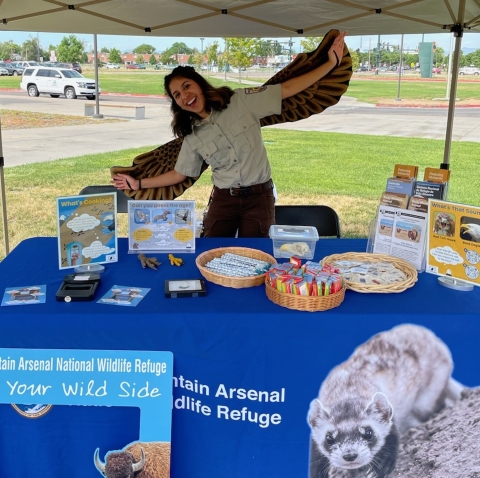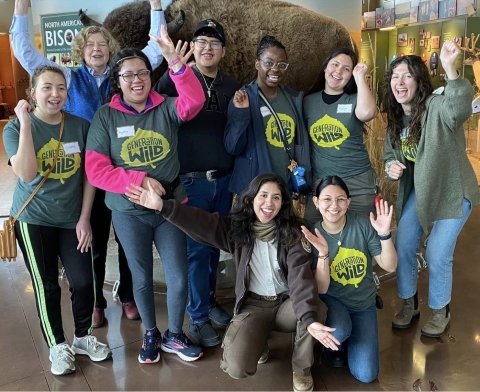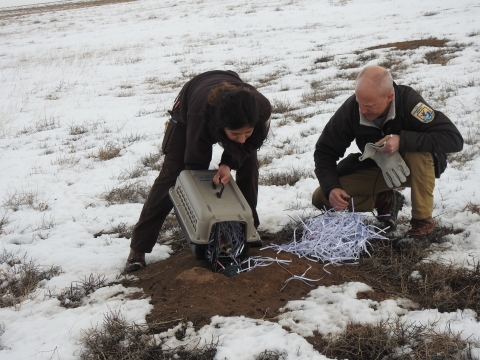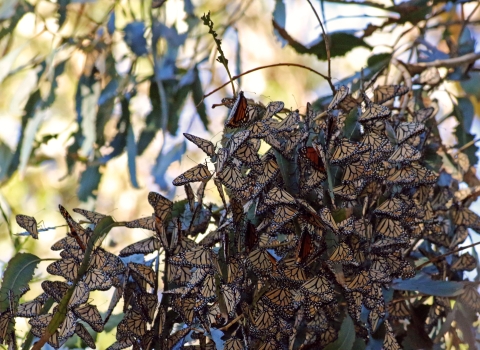Meet Isis (pronounced eesees) Rivera Lopez, Urban Park Ranger, Rocky Mountain Arsenal National Wildlife Refuge, Denver, Colorado.
What's your official title?
Isis: Urban Park Ranger
What's your REAL job title?
Isis: Environmental Education Enthusiast, Community-building Specialist, Bringer of Positive Vibes and Warmth (according to my coworkers), among many other random tasks that are part of being a Ranger.
How would you describe your conservation work to someone you just met?
Isis: My conservation work connects people to nature, specifically marginalized or historically underrepresented groups in the outdoors. At Rocky Mountain Arsenal we are uniquely located, only a few miles from the heart of the Denver metro area and surrounded by predominantly Black and Latinx communities. Our mission as a land conservation agency is relevant to these communities when people become aware and get engaged in our mission. That is why education and community-building are such important parts of conservation work and exactly what I do as an Urban Park Ranger. By facilitating connections with nature through refuge programs, outreach events and classroom visits, I create a sense of belonging/agency that will eventually inspire the next generation of land stewards and environmentalists.
What is the most enjoyable aspect of your work?
Isis: The most enjoyable part of being an Urban Park Ranger is getting to connect with people from all walks of life. I love introducing them to the refuge for the first time or strengthening their ties to the refuge through education and exciting outdoor experiences. As someone who feels passionate about social justice, due to my identity as an immigrant brown woman, I value getting to work at the intersection of environmental and social justice through my role. This may include bringing underrepresented groups to a space where they historically did not feel welcome and facilitating programming that is relevant to our communities. For example, our staff partner with organizations to bring new visitors to the refuge that include Indigenous youth, BIPOC and LGBTQ+ communities, and students from Title I schools and students with disabilities. We’ve also planned our first Latino Conservation Week at the refuge, infusing culturally significant themes such as Día de los Muertos into our environmental education. We prioritize multigenerational programming, facilitate Pride Month programming, we translated our brochures/signage/and audio tour to Spanish, and we offer refuge introductions, ferret programs, and archery lessons in Spanish. I love seeing people feel comfortable and enjoying themselves while learning about the work we do.
What is the most challenging part of your job?
Isis: I would say managing a wide range of daily tasks is the most challenging part of the job. The switch from facilitating a program, to selling an America the Beautiful pass, to responding to an emergency, to meeting with the Visitor Services Team to discuss projects, to reviewing Spanish translations in the span of just a few hours can get pretty overwhelming. The multi-disciplinary aspect of the job makes it challenging to stay on top of tasks, but that same variety is what also keeps this job so engaging. I feel like no day is ever the same as the one before.
What led to your career choice?
Isis: Growing up, I visited my grandparent’s farm often. With my cousins, I would play in the rivers, walk through green fields, eat figs and pecans straight from the trees, and help care for the farm animals. All that time outside helped me fall in love with our natural world, especially as I started seeing the contrast with the rapid development in my own hometown. Those experiences ultimately led to me pursue a career in the conservation field to protect nature and influence more people to do the same.
What is your favorite species or habitat to conserve?
Isis: When I joined black-footed ferret surveys for the first time, I got to see how the refuge comes alive at night – I saw everything from badgers and foxes, to burrowing owls and even spiders! But the highlight was finding a ferret a few minutes after I started driving! I was very nervous that I would not be able to use the spotlight and drive at the same time. Everyone bonded through the long survey nights over our favorite podcasts and music.
Throughout my time at the refuge, I’ve had the chance to work closely with black-footed ferrets - one of North America’s most endangered mammals - as a caretaker for our ambassador ferrets living in the Visitor Center ferret exhibit. I’ve gotten to see their different personalities and how absolutely adorable they are up close; my phone is full of pictures and videos of our ambassador ferrets. This iconic species is one of my favorites because I’ve learned about their conservation challenges and have seen the ongoing work to bring the species back from the brink of extinction. This past year I released a black-footed ferret in the wild for the first time which was an experience I will cherish for the rest of my life!
What is your most memorable moment from the job?
Isis: I enjoy watching kids and adults who are unsure or less than thrilled about trying archery become more confident during our sessions. Usually, they want to keep shooting or ask where they can get a bow to try archery on their own. One day, a group of young girls came to our try-it archery program and shared with their moms how surprised they were that female Rangers were leading the class. Their moms told us just how excited their girls were to see us there and thanked us for being role models to their children. It really warmed my heart to know our presence made a difference.
My first year working at the refuge, we set out nets for kids to catch moths at the Visitor Center during peak moth migration (our windows were covered in moths!). One day, due to the rainy weather, I decided to move some fieldtrip activities indoors. A group of students were exploring the Visitor Center exhibit hall, and I noticed some of the kids were interested in the nets. I explained that the nets were for catching moths and their eyes immediately lit up! We spent the next 15 minutes catching moths inside the hall and releasing them outside. To add to the excitement, birds noticed the moths being released from our back door and started swooping in to eat them. The kids were overjoyed to see the birds so up close and were happy that they could offer food for birds to eat. Their teacher later told me the kids kept going on and on about catching moths and it was one of their favorite activities during the fieldtrip! It was memorable how something so simple could turn into a fun educational activity.
What does conservation mean to you?
Isis: To me, conservation means accountability – to take care of the land that we and future generations will depend on. I think we owe it to the animals and plants to take care of their home. It is not only our survival that depends on the conservation of the land; we share this earth with so many species. Humans have been stewards of the land for centuries, so I also believe conservation action goes hand in hand with our connection to nature. In some cases, it is a way for us to reclaim that connection.
What is a fun fact about you that is not widely known?
Isis: Only those who I work closely with know that I will physically cry (like full tears running down by cheeks and everything) when I find something funny. I love laughing so it doesn’t take much to make me cry.









